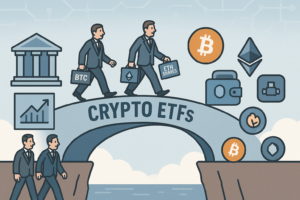
The cryptocurrency market is evolving rapidly, bringing new digital assets into the spotlight. Among them, Memecoins vs Utility Tokens remains a hot debate.
While memecoins like Dogecoin (DOGE) and Shiba Inu (SHIB) gain traction through the hype and community-driven momentum, utility tokens offer real-world functionality within blockchain ecosystems. So, when it comes to trading memecoins vs utility tokens, which one holds more value? Let’s dive into a detailed analysis.
Memecoins vs Utility Tokens: Key Differences Explained
What Are Memecoins?
Memecoins are cryptocurrencies inspired by internet culture, memes, and social trends. Unlike Bitcoin or Ethereum, they typically have no inherent utility or strong use case, relying on community-driven momentum and social media influence for value. Their price movements are heavily influenced by online discussions, influencer endorsements, and speculative trading.
How Do Memecoins Gain Value?
Memecoins gain value primarily due to social sentiment, online communities, and viral trends. Unlike traditional cryptocurrencies backed by technology or business models, meme coins thrive on hype. Their prices can skyrocket overnight due to a single tweet or celebrity endorsement, making them highly volatile and unpredictable.
Examples of Popular Memecoins
- Dogecoin (DOGE) – The original memecoin, was created as a joke but later adopted for tipping and payments.
- Shiba Inu (SHIB) – Dubbed the “Dogecoin rival,” SHIB has attracted a massive community and developed its ecosystem, aiming to offer more than just a meme-based appeal.
- Pepe Coin (PEPE) & Floki Inu (FLOKI) – Other meme-based coins with speculative potential that have gained traction.
Pros & Cons of Trading Memecoins
Pros:
High volatility, offering the potential for quick profits, and Strong community support can drive rapid price surges, Often listed on major exchanges, increasing liquidity, Frequent hype cycles create repeated trading opportunities
Cons:
High risk due to their speculative nature and lack of real-world use cases, Pump-and-dump schemes are common, leading to sudden price crashes, Limited long-term sustainability, as their success is primarily trend-based, High dependency on social media sentiment, making them unpredictable
Understanding Utility Tokens
What Are Utility Tokens?
Utility tokens are digital assets that provide access to products or services within a blockchain ecosystem. Unlike meme coins, these tokens have a defined purpose beyond speculation. They often play a crucial role in decentralized finance (DeFi), NFT marketplaces, gaming platforms, and smart contracts.
How Do Utility Tokens Work?
Utility tokens derive their value from their practical applications within blockchain networks. They can be used to pay for transaction fees, access exclusive platform features, or even participate in governance decisions. This intrinsic utility helps them maintain long-term value stability compared to meme coins.
Examples of Popular Utility Tokens
- Ethereum (ETH) – Used for smart contracts and transactions on the Ethereum network.
- Binance Coin (BNB) – Reduces trading fees on Binance and is used for various DeFi applications.
- Chainlink (LINK) – Provides decentralized Oracle services for smart contracts.
- Polygon (MATIC) – Enhances Ethereum’s scalability for decentralized applications.
Pros & Cons of Trading Utility Tokens
Pros:
Real-world use cases, increasing long-term value Strong adoption in DeFi, NFTs, and blockchain projects, and More predictable price movement compared to meme coins provide investors with practical benefits like staking and governance participation
Cons:
Lower short-term volatility compared to meme coins, making quick profits harder, heavily affected by overall crypto market trends and regulations, Some utility tokens struggle with network congestion and high fees, reducing efficiency
Memecoins vs Utility Tokens: Which One Is Worth Trading?
Short-Term Traders: Memecoins
If you thrive on high-risk, high-reward strategies, meme coins can be appealing. With their extreme volatility, traders can make quick profits if they time the market correctly. However, risk management is crucial as prices can drop suddenly due to market sentiment shifts.
Long-Term Investors: Utility Tokens
For those looking for a more stable investment with real-world use cases, utility tokens are the better option. They provide long-term value and are less likely to crash due to hype cycles. Many projects using utility tokens have continued development and innovation, increasing their value over time.
Memecoins vs Utility Tokens Trading Strategies
For Memecoins:
- Follow social media trends (Twitter, Reddit, and TikTok can drive prices).
- Set stop-loss orders to protect against sudden crashes.
- Trade during high-volume periods for better liquidity.
- Monitor whale movements and large transactions for potential price shifts.
- Be prepared for extreme price swings and adjust strategies accordingly.
For Utility Tokens:
- Analyze project fundamentals and adoption rate.
- Use technical indicators like RSI and moving averages to time entries.
- Hold for long-term gains if the project shows strong potential.
- Look for staking opportunities to earn passive income.
- Diversify investments across multiple utility tokens to reduce risk exposure.
Are They Worth Trading?
Both meme coins and utility tokens offer unique opportunities for traders and investors. If you are seeking short-term gains, meme coins provide high volatility and fast returns. If you prefer long-term stability, utility tokens offer real-world use and growth potential. Regardless of your choice, always conduct thorough research, manage risk, and stay informed about market trends.












